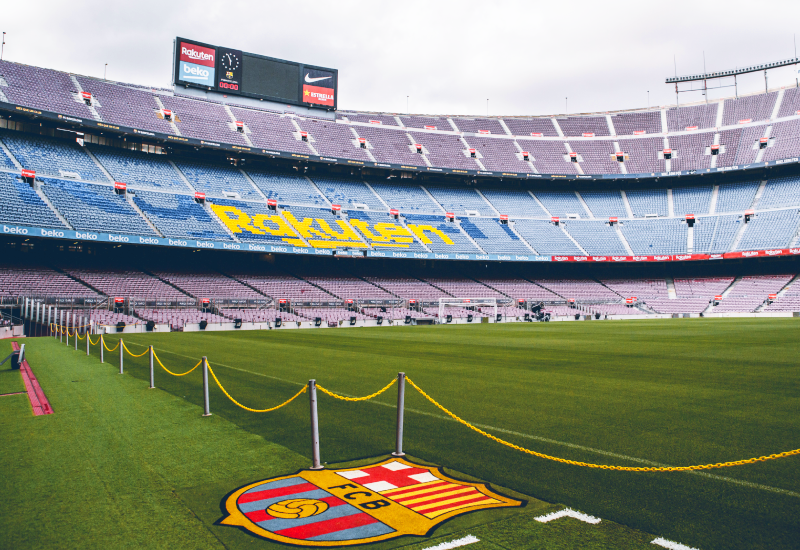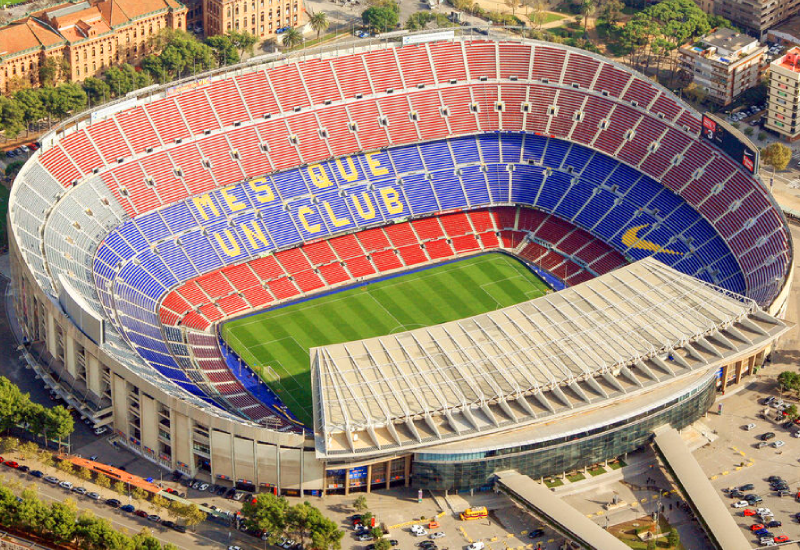Camp Nou is the largest stadium in Europe and ranks third among the largest stadiums in the world. Today, the biggest stadiums in the world are not just places for sporting events. These huge arenas host celebrations, concerts, and even religious ceremonies attended by thousands of people.
Camp Nou is one of the biggest stadiums in the world, where memorable football matches have been held. In addition to football matches, Camp Nou has hosted famous personalities such as Pope John Paul II and American singer and songwriter Michael Jackson.
In this article, we’ll have a Camp Nou Stadium tour together and get to know more about New Camp.
Camp Nou Stadium in Barcelona History
The previous stadium of FC Barcelona was called “Les Corts.” With a capacity of only 48,000, Les Corts had no room for expansion, and this led to the decision to build Camp Nou. Construction of Camp Nou began on March 28, 1953, to replace the smaller site.
The arrival of famous Hungarian player Laszlo Kubala in the summer of 1950 prompted the need for a larger stadium. The final site for the new stadium was chosen in late 1951, and land acquisition took two years. As a result, the foundation stone was laid in the spring of 1954.

Originally, the new stadium was to be called “Barcelona Club Stadium,” but it became known as “Camp Nou” (New Field), a name it has retained to this day. The cost of building this stadium was more than four times the initial estimate and reached nearly two million dollars.
In 1980, Camp Nou was upgraded to host the 1982 FIFA World Cup, including the opening match. This upgrade added VIP seats, a new press area, and a third tier of seating.
During this expansion, 22,150 seats were added, bringing the total seating capacity to 71,731, not including standing areas. With standing capacity, the total could reach 121,401. After the 1982 World Cup, the Camp Nou Museum was established in 1984.
Camp Nou Construction
The main architects of Camp Nou were Francesc Mitjans and Josep Soteras, along with the Spanish architect Lorenzo García Barbon. During the construction of the stadium, the La Masia training ground, which now trains Barcelona’s youth teams, served as a modeling and design workshop for architects and builders.
When Camp Nou was first built, it had two tiers for spectators with a capacity of 93,053. The stadium was designed as an open-air venue with only one side of the seating area covered.

The highest point of the stadium reaches a height of 48 meters. The land of New Camp has an area of 55,000 square meters. The dimensions of the playground are 105 x 68 meters, 95% of natural grass, and 5% of artificial fibers. The concrete and steel stadium was built between 1954 and 1957.
Spotify Camp Nou Stadium
Since 2022, the stadium has been known as the “Spotify Camp Nou,” as music streaming company Spotify signed a deal worth $310 million with the stadium and became its main sponsor.
Camp Nou has hosted many major football events, including two UEFA Champions League finals in 1989 and 1999, two Cup Winners’ Cup finals, five UEFA Super Cups, four Copa del Rey finals, and 21 Spanish Super Cup finals.
It has also been the venue for five games of the 1982 World Cup (including the opening game), two games of the 1964 European Nations Cup, and the final of the 1992 Summer Olympics.
Camp Nou Stadium Capacity
Camp Nou, meaning New Field, has been the home of FC Barcelona since its completion in 1957. This stadium is one of the largest stadiums in the world, with a capacity of 99,354 spectators.

This makes Camp Nou the largest stadium in Spain and Europe and the third-largest stadium in the world.
Camp Nou Stadium Renovation
Since its construction, Camp Nou has undergone two major renovations and expansions: one in 1982 and the other in 1994. On September 18, 2007, British architect Norman Foster was commissioned with a renovation project to add about 6,000 seats and to increase the capacity to 105,000. However, the project remained on the drawing board and was rejected in 2010.
The third renovation of Camp Nou is currently underway (starting in 2023) and is expected to be completed by 2026. The new design flattens the third level and includes a canopy that covers all seats, increasing the seating capacity to 105,000.
The upcoming renovation will introduce several interior changes to enhance spectator comfort. For example, the distance between the seats will be increased, and a dedicated path will be considered for the access of disabled people. Seats will slope steeper towards the ground to improve sight lines, and all seats will be equipped with screens.
A large-high-quality LED digital screen will be installed above the stadium, and access to the different levels will be made easier with wider stairs and corridors. Separate entrances will be created for fans of each team to increase security.

Smart features such as energy-saving systems and services for hearing and visually impaired spectators will be integrated into the stadium. The smart roof uses solar panels to collect and store solar energy, which is used to light the stadium.
In addition, the roof collects rainwater to irrigate the grounds and provides wireless Internet access for spectators while reducing noise pollution.
Camp Nou Stadium Facts
Largest Stadium in Europe: One of the most amazing facts about Camp Nou is that it holds the title of the largest stadium in Europe. With a capacity of over 99,000 seats, this massive venue is home to FC Barcelona and has been the venue for many major matches and events.
An Architectural Marvel: Camp Nou is not just a stadium. An architectural masterpiece, the stadium, designed by architects Francesc Mitjans, Josep Soteras, and Lorenzo García Barbon, has stunning curved bases and an impressive roof structure that adds to the majesty of the venue.
Lionel Messi’s Playground: Camp Nou has been the home of one of the greatest football legends, Lionel Messi. The Argentine superstar has captivated the audience of this iconic stadium with his incredible skills and record-breaking performances.
Camp Nou Museum
Adjacent to the stadium is the Camp Nou Museum, which houses a collection of memorabilia, awards, and exhibits showcasing the history and achievements of FC Barcelona.

It provides fans with an opportunity to delve deeper into the club’s remarkable journey.
Camp Nou Record-Breaking Attendance
Over the years, Camp Nou has consistently attracted impressive crowds, breaking records and surpassing other stadiums. The intense loyalty and unwavering support of Barca fans contribute to an incredible attendance at every home game.
Stunning Views of Camp Nou
The breathtaking panoramic views offered by Camp Nou are truly amazing. Whether you are gazing down at the pitch from the upper floors or gazing at the Barcelona skyline from the stadium, the views are amazing. Just one look at Camp Nou Photos shows the grandeur and scenic beauty of this iconic club.
Final Word
In this article, we explored the history, architecture, facilities, and cultural significance of this legendary Barcelona Stadium, examining how Camp Nou has become an important tourist destination and a global icon.
So, as you embark on your journey to Spain, make sure to visit this magnificent stadium with full awareness. Camp Nou is a symbol of excitement, history, and glory that turns dreams into reality with every match.
If you want to visit Spain cities and looking for the perfect tour of Spain, we’ve got you covered. Contact us for more information on how to book our Tours to Spain.







